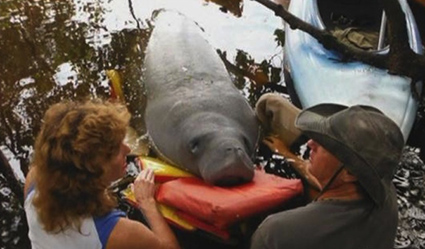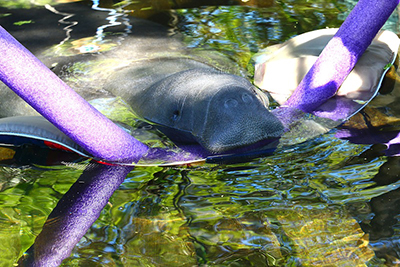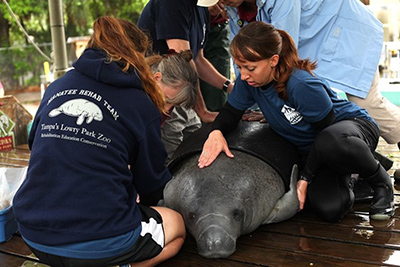
Red tide takes toll on Florida’s manatees
A bloom of red tide in the Gulf of Mexico is responsible for the deadliest spring in history for the Southwest Florida manatees, killing nearly 10 percent of the population.
The bloom has killed 256 manatees since April 8 and continues to kill 10 or more manatees per day, experts state.
| Click on the video at the right to view an audio slideshow about red tide’s effect on manatees in Southwest Florida. It was prepared by writer Hannah Hawks. |
Wildlife officials believe the algae bloom appears to have finally dissipated. However, Kevin Baxter, spokesman for of the Florida Fish and Wildlife Research Institute, explains the manatee deaths are likely to continue for a while since the toxins have settled in to sea grass that manatees eat as a large portion of their diet.
The bloom began last fall in the Gulf of Mexico in a 70-mile stretch of Southwest Florida coastline from Sarasota County to Lee County — home to nearly 5,000 manatees, 40 percent of the population of Florida’s manatees.
Red tide has been an issue for Florida’s beaches for centuries. The algae, Karenia brevis, resides in the water offshore and has the tendency to explode into a bloom, staining the water rust-color while also releasing large amounts of toxins.
At nearly 1.5 million acres in size, Everglades National Park provides an important habitat for the West Indian Manatee, a member of the endangered species list, who was severely affected. The Ten Thousand Islands region of Southwest Florida is often home to these manatees that roam in and out of the park’s waters.
 |
Tampa’s Lowry Park Zoo’s David A. Straz Jr. Manatee Hospital staff have treated over a dozen manatees sick from the exposure in spring 2013 (Photos courtesy of Dave Parkinson, Lowry Park Zoo) |
The manatees inhale the toxin in the water when they surface for air as well as ingest it in sea grass. Once the toxin is in their central nervous system, it paralyzes them leaving the manatee unable to surface for air to breathe. After only 20 minutes under water, the manatee drowns due to a lack of oxygen to the brain.
Conservation efforts have mobilized to help the manatees. Tampa’s Lowry Park Zoo rescues and treats manatees exposed to red tide.
The zoo’s manatee hospital is the only non-profit hospital in the world specifically dedicated to manatee rehabilitation, and one of just three rehabilitation facilities in Florida. The Zoo has treated nearly 300 manatees and half of those were released back to their native waters.
“We have received more than a dozen manatees sick from red tide exposure for treatment at the zoo’s David A. Straz Jr. Manatee Hospital. Presently, our hospital is the only critical care facility to treat manatees sick from red tide,” said Rachel F. Nelson, director of Public Relations of Tampa’s Lowry Park Zoo.
The treatment requires having zookeepers stand in the manatees’ water tank and hold the manatee’s head out of the water so it can breathe.
Although the zoo does have flotation devices to support the manatees’ heads, said Nelson, “they tend to have seizures, which makes them drown.” So each staffer takes a three-hour shift holding the manatees’ heads up, she said.
Manatees have been on the federal endangered species list since 1967 and have been protected by Florida state law since 1893.
| Zookeepers at Tampa’s Lowry Park Zoo use a flotation device to elevate the nose of a sick manatee helping it continue to breathe though paralyzed from red tide exposure. |  |
Kata Horvath, a post-graduate student specializing in marine ecological science in the Rosenstiel School of Marine and Atmospheric Science at the University of Miami, says the bloom has affected the habitat for numerous other species as well as humans with respiratory problems.
“Red tide has harmed people, fish, sea mammals and shellfish. With the deaths of so many manatees and other aquatic animals, the ecosystem could take years to recover,” she said.
The bloom has been present on the Southwest Coast of Florida, but has not traveled along the coastline to affect the eastern Florida waters such as Biscayne National Park.
Gary A. Bremen, a park ranger and spokesman for Biscayne National Park in South Florida, said the composition of base rock and sediments can explain why red tide hasn’t affected the eastern coasts of Florida.
“High phosphorus generally contributes to red tide. However, here we have a calcium carbonate base rock and sediments. Calcium carbonate chemically binds to phosphorus. The phosphorus values in Miami-Dade and Monroe counties are much lower than those along the west coast of Florida. Portions of the west coast of Florida near Tampa and north have phosphorous deposits and phosphate mining,” he said.
The bloom is not expected to impact the eastern coast and is dissipating daily on the west.
 |
Tampa’s Lowry Park Zoo’s David A. Straz Jr. Manatee Hospital staff methodically takes blood from “Cheer”, a manatee sick from red tide. |
Robert Showler, Flamingo District Interpreter of Everglades National Park, says red tide was the most prevalent in the Gulf Coast, Everglades City and Naples area.
“However, it seems as though the bloom has finally disappeared. It does not seem to be present in the park waters anymore”, he said. “Few if not, no diseased manatees have washed up on the shores of Florida Bay recently,” Showler said.

Comments are Closed